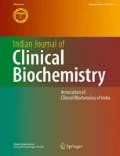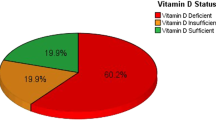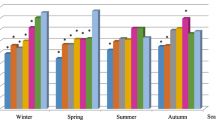Abstract
25-hydroxy vitamin D [25(OH) vit D] deficiency is a serious public health problem, particularly in the Indian sub-continent. The objective of the present study was to study the prevalence of 25(OH) vit D in different age groups. The data of 25(OH) vit D assay of 26,346 ostensibly healthy individuals, enrolled under executive health checkup at Medanta The Medicity, Gurgaon, over a period of 3 years, were extracted from the hospital information system and reviewed extensively. 25(OH) vit D deficiency (VDD) was defined as 25(OH) vit D < 20 ng/ml, insufficiency (VDI) as 25(OH) vit D between 20 and 40 ng/ml and 25(OH) vit D sufficiency (VDS) as 25(OH) D > 40 ng/mL. 25(OH) vit D deficiency (VDD + VDI) was observed in 93 % of the subject population. Maximum number of the subjects belonged to the age group of 41–60 years. 59 % had frank 25(OH) vit D deficiency when cut off level was <20 ng/mL. Mean value of 25(OH) vit D in our subjects was 21.4 ± 14.4 ng/mL. Significant difference in 25(OH) vit D level was observed in between male and female subjects. Simultaneously 25(OH) vit D levels were significantly lower in the patient visited hospital in winter-spring season than the summer-autumn season (p > 0.001). Our study demonstrates a high prevalence of 25(OH) vit D deficiency in an ostensibly healthy Indian population. There is a need for redefining our reference ranges according to our population and extensively improving the status of vitamin D.

Similar content being viewed by others
References
Ritu G, Gupta A. Vitamin D deficiency in India: prevalence, causalities and interventions. Nutrients. 2014;21:729–37.
Holick MF. Vitamin D. In: Shils ME, Shike M, Ross AC, Caballero B, Cousins RJ, editors. Modern nutrition in health and disease. 10th ed. Philadelphia: Lippincott Williams & Wilkins; 2006.
Holick MF. Evolution, biologic functions and recommended dietary allowance for vitamin D. In: Holick MF, editor. Vitamin D: physiology, molecular biology and clinical applications. Totowa: Humana Press; 1999. p. 1–16.
Tuliani TA, Shenoy M, Deshmukh A, Rathod A, Pant S, Badheka AO, et al. Major electrocardiographic abnormalities and 25-hydroxy vitamin D deficiency: insights from National Health and Nutrition Examination Survey-III. Clin Cardiol. 2014;37:660–6.
Harinarayan CV, Joshi CR. Vitamin D status in India: its implications and remedial measures. J Assoc Physicians India. 2009;57:40–8.
Hodgkin P, Hine PM, Kay GH, Lumb GA, Stanbury SW. Vitamin D deficiency in Asians at home and in Britain. Lancet. 1973;302:167–72.
Goswami R, Gupta N, Goswami D, Marwaha RK, Tandon N, Kochupilli N. Prevalence and significance of low 25-hydroxyvitamin D concentrations in healthy subjects in Delhi. Am J Clin Nutr. 2000;72:472–5.
Goswami R, Mishra SK, Kochupillai N. Prevalence & potential significance of vitamin D deficiency in Asian Indians. Indian J Med Res. 2008;127:229–38.
Lips P, Chapuy MC, Dawson-Hughes B, Pols HA, Holick MF. An international comparison of serum 25-hydroxyvitamin D measurements. Osteoporos Int. 1999;9:394–7.
Holick MF, Binkley NC, Bischoff-Ferrari HA, Gordon CM, Hanley DA, Heaney RP, et al. Evaluation, treatment, and prevention of vitamin D deficiency: an Endocrine Society clinical practice guideline. J Clin Endocrinol Metab. 2011;96:1911–30.
Mithal A, Wahl DA, Bonjour JP, Burckhardt P, Dawson-Hughes B, Eisman JA, et al. Global vitamin D status and determinants of hypovitaminosis D. Osteoporos Int. 2009;20:1807–20.
Bogh MK, Schmedes AV, Philipsen PA, Thieden E, Wulf HC. Vitamin D production after UVB exposure depends on baseline vitamin D and total cholesterol but not on skin pigmentation. J Invest Dermatol. 2010;130:546–53.
Matsuoka LY, Wortsman J, Haddad JG, Kolm P, Hollis BW. Racial pigmentation and the cutaneous synthesis of vitamin D. Arch Dermatol. 1991;127:536–8.
Clemens TL, Adams JS, Henderson SL, Holick MF. Increased skin pigment reduces the capacity of skin to synthesise vitamin D3. Lancet. 1982;1:74–6.
Guggenbuhl P. Osteoporosis in males and females: Is there really a difference? Jt Bone Spine. 2009;76:595–601.
Hollick MF. Vitamin D deficiency. N Engl J Med. 2007;357:266–81.
Marwaha RK, Puri S, Tandon N, Dhir S, Agarwal N, Bhadra K, et al. Effects of sports training & nutrition on bone mineral density in young Indian healthy females. Indian J Med Res. 2011;134:307–13.
Arya V, Bhambri R, Godbole MM, Mithal A. Vitamin D status and its relationship with bone mineral density in healthy Asian Indians. Osteoporos Int. 2004;15:56–61.
Acknowledgments
Authors are thankful to our Information Team who has helped us to extract all the data from our hospital Information system. We are thankful to Medanta Institute of Research for statistical analysis.
Author information
Authors and Affiliations
Corresponding author
Ethics declarations
Conflict of interest
Authors declares no conflict of interest.
Rights and permissions
About this article
Cite this article
Shukla, K., Sharma, S., Gupta, A. et al. Current Scenario of Prevalence of Vitamin D Deficiency in Ostensibly Healthy Indian Population: A Hospital Based Retrospective Study. Ind J Clin Biochem 31, 452–457 (2016). https://doi.org/10.1007/s12291-016-0552-2
Received:
Accepted:
Published:
Issue Date:
DOI: https://doi.org/10.1007/s12291-016-0552-2




